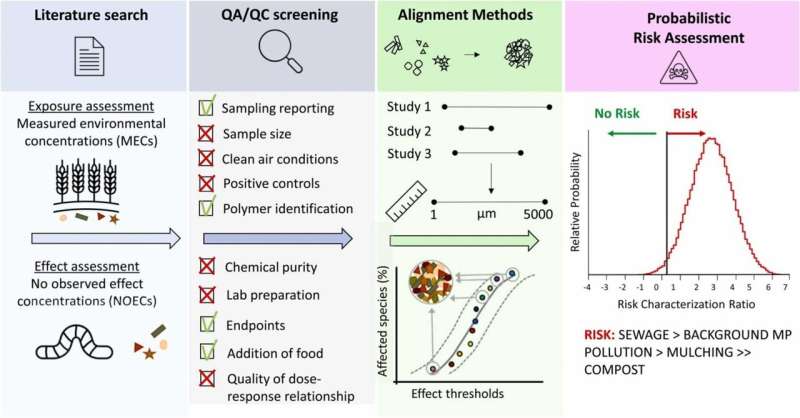This article has been reviewed according to Science X's editorial process and policies. Editors have highlighted the following attributes while ensuring the content's credibility:
fact-checked
peer-reviewed publication
trusted source
proofread
Microplastics in soils: First consistent risk assessment

Microplastics in soil are extremely diverse and complex. This makes it difficult to determine the risks of plastic pollution to soil life, which is an increasing concern among policymakers and scientists. Researchers from the Spanish Institute IMDEA Water and Wageningen University & Research now offer the first ecological risk assessment indicating that risks are to be expected.
The work is published in the Journal of Hazardous Materials.
"Our concerns regarding plastics in our environment began with the finding of plastic in the oceans. Then, attention was also paid to plastics and their adverse effects in rivers and lakes," says Dr. Paula Redondo-Hasselerharm of IMDEA Water. "Only recently have we started to look at effects on soil."
Microplastic waste has been found in soils worldwide, and emissions are expected to increase enormously in the coming years. Fragmentation leads to smaller and smaller particles. As the particles become smaller, more types of soil organisms can ingest them and, as such, the risk also increases.
Different particles for different sources
"So far, studies comparing the exposure and effects of microplastic particles in soil have, so to speak, compared apples to oranges," says Wageningen researcher Prof. Dr. Bart Koelmans. "Microplastic particles in soils are very diverse and they differ from the particles used in effect tests. You cannot compare the exposure and the effects if they concern very different particles.
"For the first time, we used a method that corrects for this. In this method, we correct for differences between microplastics in the soil and microplastic as it has been used in effect tests. For example, if the negative effect is caused by the volume of the ingested particles, then we calculate the volume of the particles in the soil and of those in the tests, so you have a fair comparison where it all adds up again."
"And we saw something else special," adds Dr. Redondo-Hasselerharm. "We saw that the plastic particles differed for different sources of microplastic, such as background pollution, for example, by deposition from the atmosphere, or pollution by applications of compost or sludge. Eventually, we even conducted four risk assessments: one for each source."
An important finding is that most soils worldwide did not yet show a risk, but for some locations, the exposure was higher than the effect threshold. So, a risk is to be expected there. Scientists agree that the number of particles will only increase in the future. Therefore, the number of soils where soil organisms are not entirely safe could also increase.
Risk assessment of microplastic
The issue of plastic pollution is high on the agenda of policymakers and the public, and society is asking for an assessment of the risks of plastic waste to people and the environment. Quantitative methods like this are expected to be of great help in informing the public about where and when risks from microplastics will arise. As long as analytical methods to detect plastic particles and methods to assess effects are all different and still in development, the new method offers a valuable tool to assess the risk of this new contamination.
At Wageningen University & Research, several new projects have been started to further develop tools for assessing the risk of nano- and microplastic in soil, in water bodies and in surface water, but also for humans, for example through inhalation or consumption of food or drinks that contain microplastics.
More information: Paula E. Redondo-Hasselerharm et al, Source-specific probabilistic risk assessment of microplastics in soils applying quality criteria and data alignment methods, Journal of Hazardous Materials (2024). DOI: 10.1016/j.jhazmat.2024.133732
Journal information: Journal of Hazardous Materials
Provided by Wageningen University





















